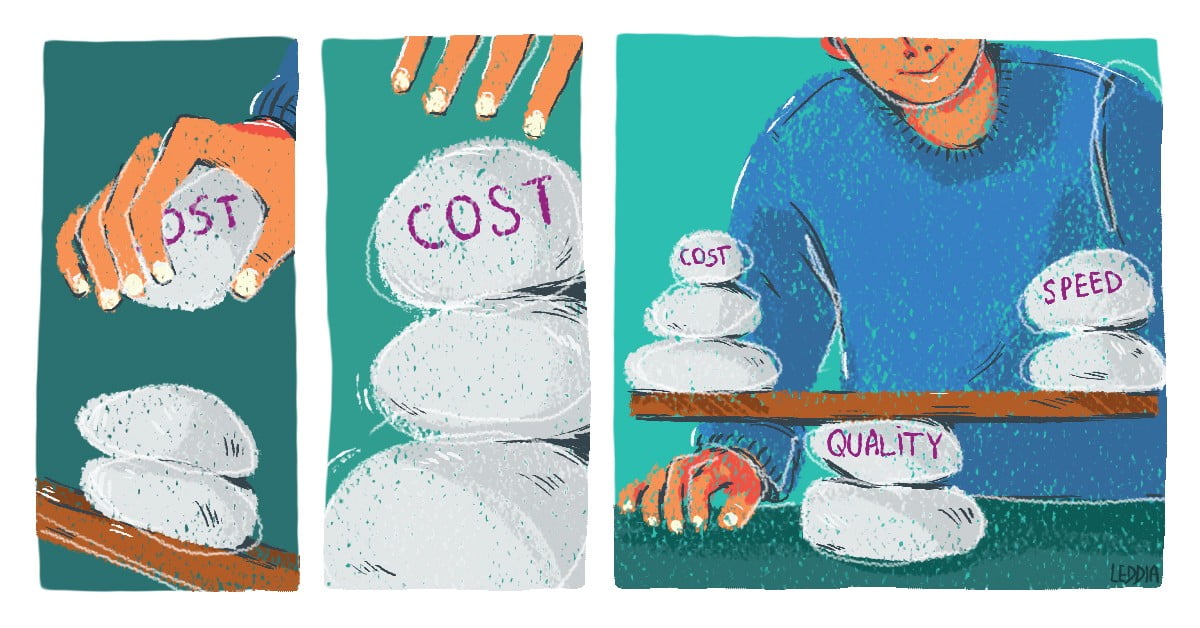
In order for recruiters to plainly communicate their hiring challenges, they must first understand the main drivers of tech recruitment — cost, quality and speed.
When it comes to Recruitment some hope for a cheap, high-quality and fast recruitment process, but this is utopian. It’s possible to maximize two of these vertices, but almost impossible to do that without compromising the third one. The equilateral triangle means that you need to have the right equilibrium between the 3 variables.
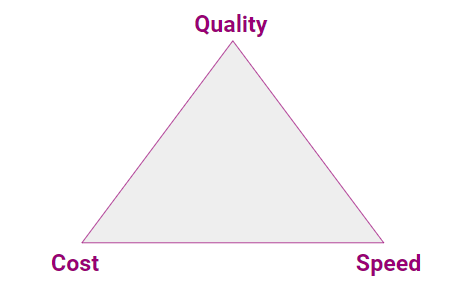
During this article let me guide you through some of the most common misconceptions I’ve seen during the course of the last 3 years. I’ll showcase a set of real examples alongside data that Landing.jobs has been collecting, while providing valuable hints to optimise your recruitment process. Let’s go deeper in each one.
QUALITY
1. A top talent candidate is not necessarily the best fit candidate.
Here’s a real life example. A fast-paced company in Germany with no brand in the market was on the hunt to find a very senior software developer. After a couple of weeks, an ex-Googler applied organically — they got super excited and prioritised this candidate, especially because they were struggling to fill the position. After the first interview, they raised certain red flags about his personality: he was considered socially awkward and clearly not a fit within the company’s culture. However, the tech team was pressuring so much that he was moved forward. In the tech interviews, he nailed it — he had the best coding challenge ever. The tech team was so excited they sent an offer right away and he accepted. After 10 weeks he got fired. You know why? Their teammates were not able to work with him — everyone was complaining about his behaviour. This means the best candidate needs to fit not only the tech requirements but also the company values.
2. Come-up with a solid recruitment plan.
Did you know that 75% of the candidates check companies’ reputation before hitting the apply button? If so, we have to be extra cautious. Before extraordinary execution, comes a solid plan. So, beforehand you need to answer questions like:
a) What are the actual needs?
b) What’s the right hiring funnel?
c) How many stages are you having?
d) Which people should be involved?
Most companies are so overwhelmed with the urgency of fulfilling a role they neglect this simple plan.
3. Define a compact candidate journey to enhance their experience.
Are you aware that 95% of the candidates who had a positive experience would refer others to apply? If this is one of the main channels for hiring, it can improve both quality and quantity of candidates. In other words, if we make sure all the candidates have great experiences, they’ll naturally recommend suitable candidates from their networks.
4. Use technology to get the right people through your door.
I keep seeing people stuck with old-fashioned tools. Are you hiring in volume and you still use Excel to track all the candidates? That doesn’t make sense — it’s a non-collaborative framework. There’s a set of alternative tools to tackle your needs called ATS (Application Tracking System). My favourite examples include Greenhouse, Workable, Recruitee and SmartRecruiters.
Additionally, the use of screening tools and other available technology will allow you allocate your time smarter and more efficiently.
5. Develop the right KPIs and be data-driven.
Do you belong to a community of recruiters who don’t track your numbers? You should be worried, since 25% of your competitors are already doing this. If you don’t track, you can’t figure out which parts of your hiring strategy need improvement. Example: Tracking your Offer Acceptance Rate will tell you if you have to review your proposed conditions.
SPEED
1. Competition is very fierce — keep ahead of it.
In an unbalanced market, we face talent shortages — which means the demand for talent is crazily above supply. On average a good candidate ends up with 3–4 valid offers on the table, giving them superior bargaining power. Therefore, when a good candidate is identified we should prioritise them and anticipate competitors’ moves. How? Simply move candidates faster between hiring stages. Also, having good ratings on platforms like Glassdoor will help you to keep ahead of your competitors.
2. Agility must be prioritised.
The world is changing fast and now Millennials are the biggest workforce generation. Millennial traits include nonconformism, tech-savvy and being prone to jump from job to job. If that’s the case, we need to be agile enough to get their attention. The old-fashioned techniques from 10 years ago don’t work anymore, it’s time to be creative and innovative when it comes to Talent Acquisition techniques.
3. Don’t hire too fast.
Go back to the first real example and see the effect of hurrying decisions and jumping recruiting stages. As mentioned, this will jeopardise not only the quality but also the costs (of a bad hire — you’ll find how expensive this could be later on this article). Let me come up with an analogy about pregnancy. If a child is born too fast (before 24 weeks) or too slow (after 42 weeks), his/her survival chances are way lower. In life everything has the right timing, so be agile, but be considerate.
4. Speak up, because people expect it.
From Baby Boomers to Gen Z, they all see silence as a No!. Consider a typical example (see the graph below). Today I apply for a job in your company. Today I am 100% interested in knowing more. If a week has passed and I haven’t heard from you, I start considering new opportunities and my interest decreases. After two weeks, I start new hiring processes with your competitors and the interest goes down. After 4 weeks I have already received a couple of job offers, so I am likely no longer interested. Any longer and I’ll have a negative impression about your recruitment process, most likely making me a detractor of your brand image. Again — knowing that candidates check companies’ reputation before applying — that’s an issue. The key takeaway is that instead of remaining silent, interaction with your candidates is vital. Try to manage their expectations on a recurring basis — even when you don’t have a final answer, try to keep them engaged in the process.
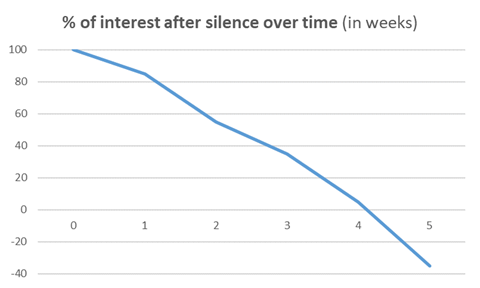
COSTS
1. Know your real hiring costs.
I keep asking all the time if the recruiting managers know their recruiting costs. Most of them say No! and ask me for help to find the exact answer. The first thing we should do is to measure the Cost Per Hire, which is the result of combining internal with external costs and divide it by the number of hires made. So which costs should be accounted?
Internal Costs:
a) In-house recruiting teams. How much do you pay your team during the time you are considering?
b) Management team. How much time other team members spent in the process clarifying needs, setting up interviews or even giving feedback?
c) Office work & perks. How much do the involved team members cost in terms of office space and additional benefits?
d) Onboarding and training. What’s the underlying cost of onboarding and initial training sessions? Consider the income of your new hires but also the ones teaching them.
External Costs:
a) Advertising & Employer Branding Costs. How much are you spending on digital or offline promotions? Which events is your team participating in? Don’t forget to consider their time.
b) Technology. What’s the amount spent on tools to perform coding challenges or in ATS?
c) Recruiting suppliers. How much are you paying in direct fees?
d) Consulting services. Do you have additional costs with experts who provide valuable advice? Consider them here.
e) VISA, Relocation & Travel expenses. Are you paying flights for the final interview? Or maybe offering a relocation package? Don’t forget to include them all.
This seems like a lot to measure, but only after that, you’ll see the real surprise of how much a new hire costs you. Apologies in advance, but I feel like spoiling you, on average a hire costs 25.000€ in Europe. I hope this emphasises how important cost is as a factor and why it is vital to avoid hiring mistakes.
2. Understand the modern Talent Acquisition funnel.
The role of a recruiter becomes wider in functions with the growing importance of this subject. The new TA funnel includes not only the traditional recruiting stages: Application-Evaluation-Hire but also a set of prior stages that we can call the Recruitment Marketing stages: Awareness-Consideration-Interest. This means that to be able to attract candidates, ie. generate applications we should start earlier on with a couple of marketing and employer branding initiatives.
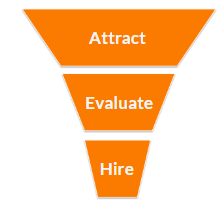
3. Understand the importance of having an in-house team.
I am a big fan of automation, but I don’t believe it can replace humans in the process. There are no algorithms able to understand emotions or assess the cultural fit between an individual and a team. This kind of complexity should be undoubtedly managed by people. Training your staff to assess the cultural fit helps avoid bad recruiting decisions, i.e., it saves you tons of money and gets the right people in your business.
4. Embrace technology.
Does it sound efficient to you if your team is doing many repetitive tasks? Not at all. Not only is inefficient but also a big downfall in terms of your team motivation, especially when dealing with Millennials and Gen Z, who are mostly against repetitive tasks. Understand the available technology in the market and help yourself by adopting it. We talked before about ATSs, but there are new solutions popping up in the market to help you curate misfit applications, as well as evaluate the technical fit of a candidate. Adopting it will make the whole process more efficient.
So, let’s try to understand the shift that was made in the recruiting industry. In the early 1990s, most companies were outsourcing the whole TA funnel. This means they had no control over the kind of candidates that were landing at the company. It was a very fast process, but super expensive and extremely low quality.
Therefore, recruitment agencies saw a great opportunity to attract and evaluate candidates, but the hiring decisions transferred to the candidates. The effect was that the quality of hire increased, but the process became super slow and was still too expensive.
That said, we watched the rise of the job boards, trying to tackle the cost and speed vertices. These boards were responsible just for the attraction part, being super-fast and cheaper. The issue was that they compromised the quality, which went down drastically. It brought the additional hassle of companies hiring people just to screen candidates. These screeners are spending the day sending rejection notes to unfit candidates. This is a waste of good resources that could be doing something more relevant.
That’s why the industry is being shaken up again and you’ve seen the rise of tech jobs marketplaces that complement in-house teams. This way, these companies are responsible for attracting the right candidates and curating them. This means only suitable candidates will reach your desk and your team can focus on cultural-fit assessments. This means that blending technology and people is the most efficient way of ensuring an effective recruiting process.
Now that we all understand the key angles that affect the recruiting process, it’s time to roll up our sleeves and do something to improve it. My recommendation is that you put these thoughts together and build a solid Talent Acquisition strategy that blends some key psychological techniques with relevant data while emphasising the savings you are bringing to the company. If you prove to have an analytical framework that will end up being more cost-efficient, I am sure your CEO and management team will understand and support you along the way.
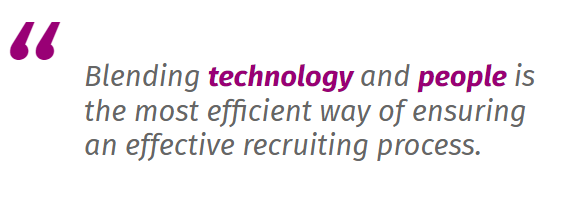
Some notes about the author (Diogo Oliveira):
On a quest to make tech recruitment a more pleasant experience to everyone, Diogo is heading the Operations Department at Landing.jobs. Trained to be cost-efficient, he has been actively advising the recruiting teams of the most fast-paced tech companies in Germany, Spain, Netherlands and Portugal. He has decided to write these thoughts down as a consequence of a talk at the Tech Hiring Conference in Lisbon. In case you want to register for the next edition, here’s the link.






0 Comments